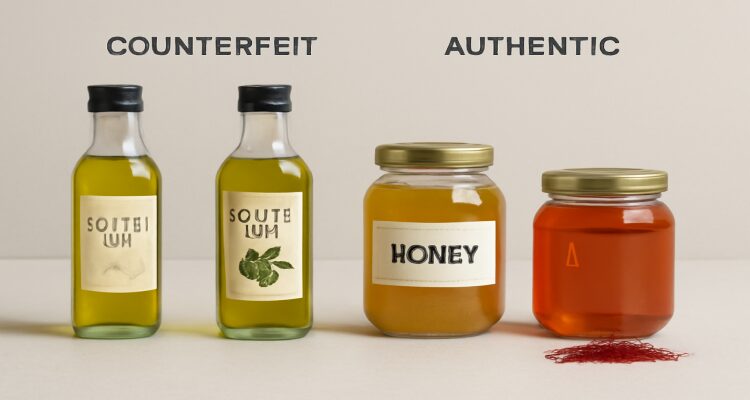The Secret World of Food Forgeries: Olive Oil, Honey, and More

Food fraud is a billion-dollar global problem. From olive oil to honey, uncover how food forgeries affect consumers, farmers, and markets worldwide.
Introduction: A Bitter Taste Behind Sweet and Golden Goods
At first glance, your kitchen shelves may look harmless: a bottle of extra virgin olive oil, a jar of golden honey, maybe even a package of saffron tucked away for special occasions. But experts warn that some of the staples we trust most are also the most frequently forged. Behind glossy labels and promises of purity lies a shadowy world of food fraud—an underground economy where adulterated or counterfeit products slip into legitimate supply chains, deceiving consumers and costing global markets billions of dollars each year.
Context & Background: What Exactly Is Food Fraud?
Food forgeries—or “food fraud,” as regulators often call it—refer to the deliberate mislabeling, dilution, or substitution of food products for economic gain. Unlike basic contamination, which is often accidental, food forgery is an intentional act.
The global food fraud market is estimated to cost nearly $50 billion annually, according to the Food Fraud Database. The issue isn’t new. Roman writers complained of merchants diluting wine with water. Today, the targets have shifted to high-value commodities: olive oil, honey, fish, spices, and even wine.
Why these products? Their production processes are complex, and authentication is challenging. Pure, high-quality olive oil can cost several times more than lesser blends. Authentic honey, with its time-intensive harvesting, fetches a high price. Crooked producers exploit these gaps for profit, often without consumers ever realizing they’ve been tricked.
Main Developments: Olive Oil, Honey, and Beyond
Olive Oil: Liquid Gold with a Counterfeit Problem
Renowned nutritionists often call olive oil “liquid gold.” Yet studies show that a large share of olive oils sold as “extra virgin” don’t meet the international standard. Some are diluted with cheaper oils like sunflower or soybean, while others are falsely labeled as premium extra virgin despite failing purity tests.
Italy, Spain, and Greece—the world’s largest exporters—have long wrestled with fraudulent labeling practices that damage their reputation. In recent years, high-profile seizures in Europe and the U.S. have shed light on how widespread the problem remains.
Honey: The Sweet Deception
Honey is no less vulnerable. Testing in global markets has revealed that much of what’s sold as “pure honey” is, in fact, blended with sugar syrups, rice syrup, or other sweeteners. Since honey’s price fluctuates based on scarcity and demand, counterfeiters step in with cheap substitutes.
Large retail chains have been caught unknowingly selling adulterated honey, which not only deceives consumers but also devastates local beekeepers struggling to compete.
The Wider Web: Spices, Wine, and Seafood
It doesn’t stop at honey and olive oil. Saffron, one of the world’s most expensive spices by weight, is often counterfeited with dyed corn silk or marigold petals. Bottles of “vintage” wine sometimes contain blends of low-cost grapes. Seafood substitution is rampant, with consumers buying cheaper fish mislabeled as snapper or tuna.
These practices not only impact trust but, in some cases, carry serious health risks when allergens or contaminants are introduced.
Expert Insight & Public Reaction
Dr. Maria Ortega, a food authenticity researcher in Spain, says:
“Food fraud is an invisible crime. Consumers rarely notice the difference in taste until the damage is revealed by testing. It’s not just about economics; it’s also about food safety and consumer trust.”
Public reaction has been one of frustration and uncertainty. With so many cases exposed by investigations, many consumers no longer know which brands to trust. Social media debates show growing demand for farm-to-table traceability and blockchain-based certification systems.
Impact & Implications: Who Pays the Price?
The fallout of food forgery is widespread:
-
Consumers: Pay premium prices without receiving authentic quality, and in rare cases, risk health hazards.
-
Farmers & Beekeepers: Struggle to compete against artificially cheap, fraudulent goods undercutting the market.
-
Global Trade: Countries risk damage to their reputations, and legitimate producers face increasing regulation and testing costs.
-
Governments & Regulators: Spend millions developing testing technologies and enforcement systems to safeguard food integrity.
Looking forward, researchers predict that DNA testing, isotope analysis, and blockchain tracking will become key tools in ensuring authenticity. The European Union, FDA, and Codex Alimentarius Commission have already implemented tighter frameworks, but enforcement remains a constant battle against innovation in fraud tactics.
Conclusion: A Hidden War Over What We Eat
Food forgeries remind us of a sobering truth: even the simplest items in our kitchens may not be what they seem. While regulators and scientists continue to fight this fraud, consumer awareness is the first defense. By supporting trusted producers, seeking transparent supply chains, and demanding accountability from retailers, everyday people can help reduce the market for fake food.
The fight against food forgery is far from over. As new technology empowers counterfeiters, it equally equips watchdogs and consumers to expose them. What remains clear is this: in the secret world of counterfeit foods, knowledge is power—and vigilance is everything.
Disclaimer: This article is for informational purposes only. It highlights the issue of food fraud based on investigative research and expert commentary. Consumers should consult official food safety authorities for verified information about specific products or brands.









